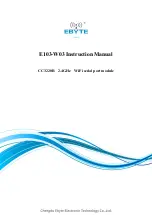
Chengdu Ebyte Electronic Technology Co., Ltd.
E103-W03 _User Manual _EN_V1.1
Copyright ©2012–2022, Chengdu Ebyte Electronic Technology Co., Ltd
.
8
Chapter 5 Function Description
The working mode of this module is divided into three levels: working role; transmission mode; service category.
From the perspective of the role of the WiFi layer, it can be divided into Access Point, which is commonly referred to as
an AP access point, Station, which is commonly referred to as a station, and WiFI-Direct is also called P2P or WiFi direct
connection;
In terms of transmission mode, it is divided into single-mode transparent transmission and protocol transmission;
From the service category, it is divided into TCP Server, TCP Client, UDP, MQTT, HTPP client.
5.1 Job roles
Job roles are defined based on the perspective of the WiFi physical layer.
5.1.1 Access Point (AP mode)
Access Point, referred to as AP mode, is similar to a router, allowing wireless devices to connect and establish server,
client, and UDP communications based on TCP/IP. In this mode, 4 stations are supported, and a maximum of 4 Tcp
socket transmissions are supported. The command AT+MODE=1,x,x sets the first bit to 1 to configure the module to
work in the role of AP.
5.1.2 Station (STA mode)
The Station mode is referred to as STA. The module under this role does not provide connection, but can only be
connected to Access Point or router. This module under the role of Station supports TCP server, TCP client, UDP, and
supports a maximum of 4 sockets. MQTT, WebSocket, HTTP clinet are also supported. The instruction AT+MODE=2,x,x
sets the first bit to 2, to configure the module to work in the STA role.
5.1.3 WiFi Direct (P2P mode)
WiFi Direct mode is a way to directly establish a point-to-point connection without routing, also called P2P, which is
similar to Bluetooth but the transmission rate is significantly higher than Bluetooth. The instruction AT+MODE=3,x,x
sets the first digit to 3 to configure the module to work in WiFi Direct mode.
There are two roles in P2P mode: Client; GroupOwner.
5.2 Transmission mode
To be precise, the transmission mode refers to the number of sockets supported by the module under the TCP/IP protocol.
When only one socket is supported, we define it as single-mode transparent transmission, and when it supports multiple
sockets, we define it as protocol transmission. It should be noted that the transmission mode parameter does not take












































